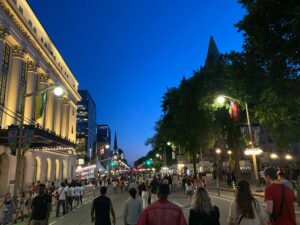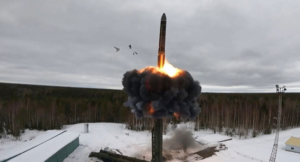
They’re affixed to old buildings where someone important used to live. Or they’re mounted on a rock overlooking somewhere where something once happened.
Cast in bronze or lettered on a sign, they’re sometimes the only history lesson many of us ever get. And now Parks Canada wants hundreds of them changed.
“The way that many of the national historic designations are framed and positioned does not do justice to the breadth of impacts that they had on Canadian society,” said Patricia Kell, the agency’s director of heritage.
Parks is in the middle of a three-year program to re-examine and rewrite the plaques that the Historic Sites and Monuments Board use to point out places deemed important to understanding Canada’s past.
Sites slated for rewrite include fur trade forts such as Fort Langley in British Columbia and Manitoba’s York Factory. Others relate to the War of 1812, like Queenston Heights in Ontario.
Some involve historic figures who held beliefs at odds with current standards. They include one of the Fathers of Confederation, John A. Macdonald; Archibald Belaney, otherwise known as Grey Owl; and Nicholas Flood Davin, founder of one of the West’s first newspapers.
The rationale for the changes, as well as a list of priority sites, is outlined in a document obtained under Freedom of Information legislation.
The document says that out of 2,192 historic sites, about two-thirds of plaque texts are fine. Of the remainder, more than 200 are considered high priorities for change.
Reasons include ignoring Indigenous contributions or using antiquated language, such as “Indian” or “Eskimo.” Another issue is controversial beliefs held by historical figures.
The most common reason for rewriting — covering plaques for French explorer Jacques Cartier, Alberta’s Bar U Ranch and Nunavut’s Kekerten Island Whaling Station — are “colonial assumptions,” the document says.
“Plaque texts can be described as ‘Whiggish’ in character,” it says. “This refers to a form of history where the progress of western civilization is understood as inevitable.
“Earlier assumptions about Canadian history that have excluded Indigenous people, among others, can no longer be accepted.”
Those plans have drawn accusations of presentism — the mistake of judging the past by standards of the present. Such charges have been levelled by Larry Ostola, former vice-president of heritage conservation at Parks Canada.
“A new woke perspective is being imposed on what was formerly an apolitical, fact-driven historical designation process,” he wrote in the National Post.
But Kell said the changes are being partly driven by the 2015 report of the Truth and Reconciliation Commission. One of the calls to action recommended Canada “develop a reconciliation framework for Canadian heritage and commemoration.”
She said it’s an attempt to use the latest scholarship to broaden the stories told, not erase familiar ones.
“They build on what was there before. They take that as a starting point and add additional layers and voices.
“It’s important to continue to reflect on these events. There are additional layers of understanding about them and some of those understandings are not celebratory.”
This mound of rocks is the earliest known funeral monument in the New World and marks the burial place of an Indian child who died about 7,500 years ago. The Maritime Archaic people, to whom the child belonged, occupied this area between 9,000 and 3,500 years ago. The body was covered with red ochre, wrapped in skins or birch bark, and placed in a large pit 1.5 metres deep. Fires were lit on either side of the body, and several spearheads of stone and bone placed beside the head. A walrus tusk, harpoon head, paint stones and a bone whistle were also placed with the body.
This is the site of the oldest known First Nations funerary monument in North America. Dating to the Maritime Archaic period about 7,700 years ago, the carefully built mound of rocks over a stone burial box marked the grave of a young person. Interred with reverence, the body was covered with red ochre and fires were lit on either side. Placed with it were stone and bone spearheads, a walrus tusk, a bone whistle, and the earliest known toggling harpoon in the world. Ancient camps of different ages and cultures found on these beaches make this one of the longest used Indigenous habitation sites in Labrador.
Many of the high-priority sites are old fur trade forts.
“Many designations associated with the fur trade have excluded the essential role of Indigenous people,” the document says. “By … providing recognition of the necessary partnership that existed between the two cultures, this gap in historical significance will begin to be rectified.”
Concerns over how Indigenous perspectives are included also affects sites associated with the War of 1812, in which many First Nations warriors fought alongside British troops and Canadian militias.
Other plaques are trying to come to grips with ideas many famous and accomplished Canadians publicized that are today considered abhorrent.
William Osler, sometimes called the father of modern medicine, mocked Indigenous people and wrote Canada “should be a white man’s country.”
But Bob Coutts, for many years the chief historian of the Historic Sites and Monuments Board, said it’s a mug’s game trying to decolonize sites that are historic, largely because of their role in colonization.
“The story still focuses on a colonialist story,” he said. “You could pad it a little bit, but it’s still going to be a plaque about the building of a fur trade fort.”
As well, the whole idea of plaques depends on written history. That works against Indigenous history, Coutts said.
“Those rules lend themselves to white, colonialist history. Someone wrote it down.”
What gets commemorated is changing, said Kell.
“We are actively working with members of a variety of communities who have not been well served in order to ensure there are subjects of importance to them that are becoming part of our national program of commemoration.”
Priority areas for that effort include the history of diversity, Indigenous history and environmental history.
Still, messing with history is always going to be complicated, said Coutts.
“I love stories that are complex. That’s what history is. There isn’t a narrative that goes from A to B.
“On the other hand, there’s still a story in there somewhere that needs to be told.”







